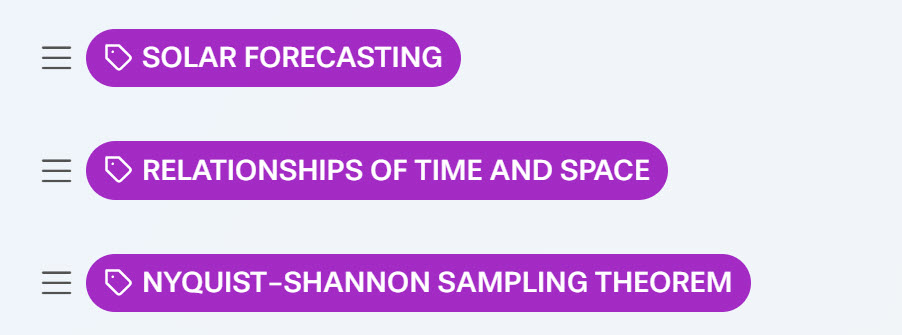Relations in Time and Space
You have been reading about the relations between time and space, and you have read about different time horizons of interest to the solar energy and electric grid fields. Now, let us apply that knowledge to Table 8.2 from the Chapter by Coimbra, Kleissl, and Marquez (2013).
| Technique | Sampling Rate | Spatial Resolution | Spatial Extent | Suitable Forecast Horizon | Application |
|---|---|---|---|---|---|
| Persistence | High | 1 point | 1 point | Minutes | Baseline |
| Sky-Imagery | 30 sec | 10-100 m | 2-5 m radius | Tens of minutes | Short-term ramps, regulation |
| GOES Satellite Data | 15 min | 1000 m | U.S.A. | 5 hours | Load following |
| NAM weather model | 3600 sec | 12 km | U.S.A. | 10 days | Unit commitment |
Questions to discuss:
- Based on the FRYB (Fujita-Rayl-Young-Brownson) relation of 17 m/s and the given "Sampling Rate" for each method (in Table 8.3), what is the characteristic meteorological distance scale being sampled (easy conversion)? How do those distances compare to the "Spatial Resolution" scales provided in the table?
- Now take a moment to read up on the Nyquist-Shannon Sampling Theorem, where you will focus on the Nyquist rate. Do all of the systems listed in the table meet the Nyquist sampling rate, and if so, for what minimum resolution?
Please share your reflections on these questions in the Yellowdig community. I wonder if everyone will come to the same conclusions.
Tagging
When you create a post in the Yellowdig discussion space, you are required to choose a topic tag. For Lesson 8 discussion, please use these tags:

Grading
Yellowdig points you earn over the weekly point earning period (from Saturday to next Friday) will count towards 1000 pts. weekly target. But you can go above it (to 1350 pts. max). Yellowdig discussions will account for 15% of the total grade in the course.
Deadline
There is no hard deadline for participating in these discussions, but beware of the weekly limit. You need to create posts every week to stay on target with your total discussion participation grade. Each weekly point earning cycle ends Friday night, and a new period starts on Saturday.
